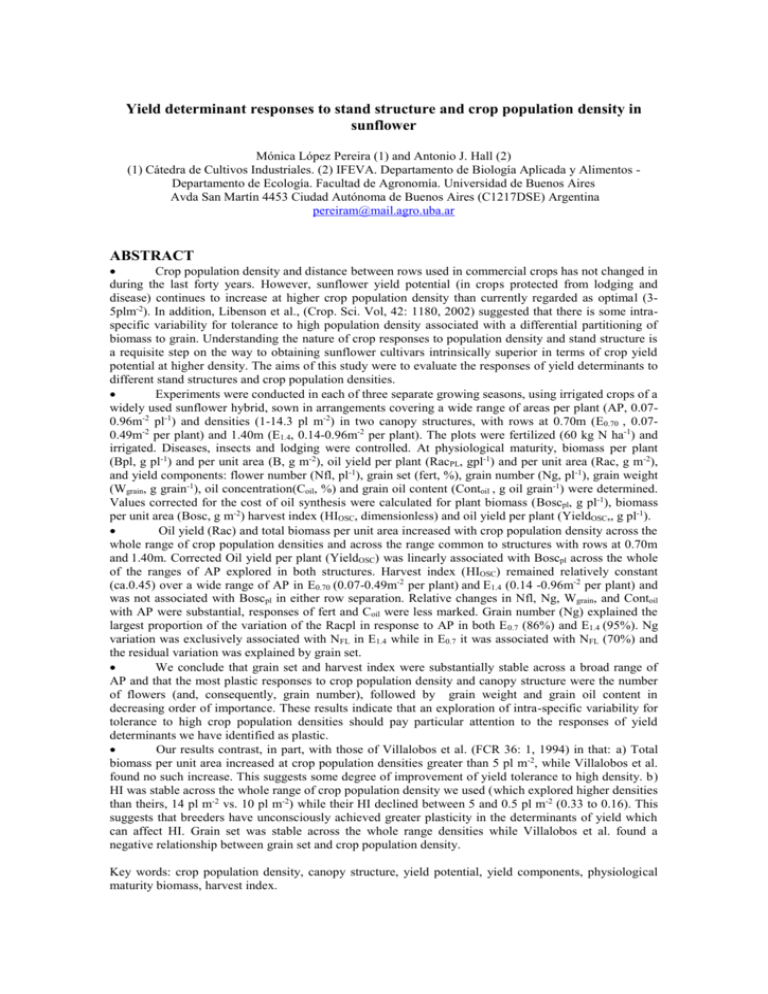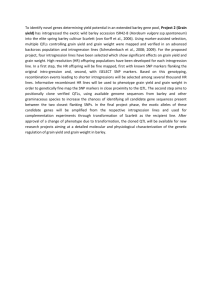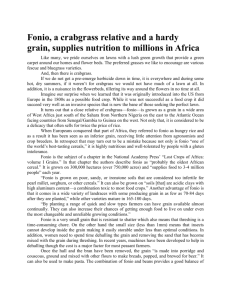Yield determinant responses to stand structure and crop
advertisement

Yield determinant responses to stand structure and crop population density in sunflower Mónica López Pereira (1) and Antonio J. Hall (2) (1) Cátedra de Cultivos Industriales. (2) IFEVA. Departamento de Biología Aplicada y Alimentos Departamento de Ecología. Facultad de Agronomía. Universidad de Buenos Aires Avda San Martín 4453 Ciudad Autónoma de Buenos Aires (C1217DSE) Argentina pereiram@mail.agro.uba.ar ABSTRACT Crop population density and distance between rows used in commercial crops has not changed in during the last forty years. However, sunflower yield potential (in crops protected from lodging and disease) continues to increase at higher crop population density than currently regarded as optimal (35plm-2). In addition, Libenson et al., (Crop. Sci. Vol, 42: 1180, 2002) suggested that there is some intraspecific variability for tolerance to high population density associated with a differential partitioning of biomass to grain. Understanding the nature of crop responses to population density and stand structure is a requisite step on the way to obtaining sunflower cultivars intrinsically superior in terms of crop yield potential at higher density. The aims of this study were to evaluate the responses of yield determinants to different stand structures and crop population densities. Experiments were conducted in each of three separate growing seasons, using irrigated crops of a widely used sunflower hybrid, sown in arrangements covering a wide range of areas per plant (AP, 0.070.96m-2 pl-1) and densities (1-14.3 pl m-2) in two canopy structures, with rows at 0.70m (E0.70 , 0.070.49m-2 per plant) and 1.40m (E1.4, 0.14-0.96m-2 per plant). The plots were fertilized (60 kg N ha-1) and irrigated. Diseases, insects and lodging were controlled. At physiological maturity, biomass per plant (Bpl, g pl-1) and per unit area (B, g m-2), oil yield per plant (RacPL, gpl-1) and per unit area (Rac, g m-2), and yield components: flower number (Nfl, pl-1), grain set (fert, %), grain number (Ng, pl-1), grain weight (Wgrain, g grain-1), oil concentration(Coil, %) and grain oil content (Contoil , g oil grain-1) were determined. Values corrected for the cost of oil synthesis were calculated for plant biomass (Boscpl, g pl-1), biomass per unit area (Bosc, g m-2) harvest index (HIOSC, dimensionless) and oil yield per plant (YieldOSC,, g pl-1). Oil yield (Rac) and total biomass per unit area increased with crop population density across the whole range of crop population densities and across the range common to structures with rows at 0.70m and 1.40m. Corrected Oil yield per plant (YieldOSC) was linearly associated with Boscpl across the whole of the ranges of AP explored in both structures. Harvest index (HIOSC) remained relatively constant (ca.0.45) over a wide range of AP in E0.70 (0.07-0.49m-2 per plant) and E1.4 (0.14 -0.96m-2 per plant) and was not associated with Boscpl in either row separation. Relative changes in Nfl, Ng, Wgrain, and Contoil with AP were substantial, responses of fert and Coil were less marked. Grain number (Ng) explained the largest proportion of the variation of the Racpl in response to AP in both E 0.7 (86%) and E1.4 (95%). Ng variation was exclusively associated with NFL in E1.4 while in E0.7 it was associated with NFL (70%) and the residual variation was explained by grain set. We conclude that grain set and harvest index were substantially stable across a broad range of AP and that the most plastic responses to crop population density and canopy structure were the number of flowers (and, consequently, grain number), followed by grain weight and grain oil content in decreasing order of importance. These results indicate that an exploration of intra-specific variability for tolerance to high crop population densities should pay particular attention to the responses of yield determinants we have identified as plastic. Our results contrast, in part, with those of Villalobos et al. (FCR 36: 1, 1994) in that: a) Total biomass per unit area increased at crop population densities greater than 5 pl m-2, while Villalobos et al. found no such increase. This suggests some degree of improvement of yield tolerance to high density. b) HI was stable across the whole range of crop population density we used (which explored higher densities than theirs, 14 pl m-2 vs. 10 pl m-2) while their HI declined between 5 and 0.5 pl m-2 (0.33 to 0.16). This suggests that breeders have unconsciously achieved greater plasticity in the determinants of yield which can affect HI. Grain set was stable across the whole range densities while Villalobos et al. found a negative relationship between grain set and crop population density. Key words: crop population density, canopy structure, yield potential, yield components, physiological maturity biomass, harvest index. INTRODUCTION Sunflower yield potential (in crops protected from lodging and disease) continues to increase at higher crop population density than currently regarded as optimal (3-5plm-2) (Lopez Pereira et al., 2004). Understanding the nature of crop responses to population density and stand structure is a requisite step on the way to obtaining sunflower cultivars intrinsically superior in terms of crop yield potential at higher density. This approach has been successfully exploited by maize breeders in the past 20 years in the United States. The higher yield of modern cultivars of maize in the U.S. is associated with a greater tolerance to higher crop population densities. The accumulation and partitioning of biomass to reproductive structures determine the yield response to density and row spacing. Both attributes are strongly influenced by vegetative and reproductive plasticity. For example, modern maize hybrids exhibit greater tolerance to high densities than older cultivars (Tollenaar and Lee, 2002) due to greater stability in harvest index. This increase in harvest index stability is linked to greater reproductive plasticity and a lower threshold biomass for producing grain yield. While sunflower has intraspecific variability for the number of flowers and seeds, its reproductive plasticity is considered to be less than its vegetative plasticity. Vega et al. (2001a) determined that the reproductive plasticity of sunflower in uniform canopy is intermediate between soybeans and corn, because it has a strong apical dominance and no ability to generate axillary reproductive buds. A lower harvest index per plant at high and low density limits the reproductive plasticity of sunflower. A restriction on the maximum number of differentiated florets per plant and the presence of sterile plants at low and high density, respectively, were the reasons that caused these reductions in harvest index (Vega et al., 2001b). The aims of this study were to evaluate the responses of yield determinants in a wide range (1-14.3 pl m-2) of crop population densities in two different stand structures to: i) quantify and compare the physiological yield capacity in sunflower crops (i.e., that which is achieved using currently available cultivars in crops protected against lodging (both root and stem) and diseases) and ii) identify the physiological mechanisms underlying the yield response to crop population density and canopy structure. MATERIALS AND METHODS Three experiments were conducted at the experimental field of the Facultad de Agronomía, Universidad de Buenos Aires (34º 35´ S., 58º 29´W.) in each of three separate growing seasons, using irrigated crops of a widely used sunflower hybrid (Contiflor 9), sown in arrangements covering a wide range of areas per plant (AP, 0.07-0.96m-2 pl-1) and densities (1-14.3 pl m-2) in two canopy structures, both with rows (oriented N - S), at row widths of 0.70m (0.07-0.49m-2 per plant) and 1.40m (0.14-0.96m2 per plant). Crops were over-sown and desired crop structures were established by removing plants from the over-sown stand at the two-leaf stage. Experiments were laid out in a split plot design (Experiment 1) or a randomized complete block design (Experiment 2 and 3), both with three replications. The plots were fertilized (60 kg N ha-1) and irrigated. Diseases, insects and lodging were controlled with pesticides and fungicides. At physiological maturity, biomass per plant (Bpl, g pl -1) and per unit area (BC, g m-2), oil yield per plant (RacPL, gpl-1) and per unit area (Rac, g m-2), and yield components per plant: flower number (Nfl, pl-1), grain set (fert, %), grain number (Ng, pl -1), grain weight (Wgrain, g grain-1), oil concentration(Coil, %) and grain oil content (Contoil, g oil grain-1) were determined. Oil yield was calculated using grain oil concentration (% dry matter) which was measured by nuclear magnetic resonance (Oxford 4000, Oxford Analytical Instruments). Values corrected for the cost of oil synthesis were calculated for plant biomass (Boscpl, g pl-1), oil yield per plant (YieldOSC, g pl-1) and harvest index (HIOSC,, dimensionless), so that these variables were comparable in energy terms across treatments (Hall et al., 1984). The HIOSC was calculated as the ratio between YieldOSC and Boscpl. Analysis of variance and regression analysis were used to establish significance (P< 0.05) of differences among treatments and associations between variables. RESULTS Duration of the pre-anthesis phase was 52 (Exp. 1), 45 (Exp. 2) and 60 (Exp. 3) days from emergence. The post-anthesis phase was completed in 45 days in all experiments. Higher temperatures during the Exp 2 growing season increased the rate of development resulting in a shorter duration of this phase. 500 1000 400 750 500 250 0 0.00 0.8 Harvest index osc 1250 Yieldosc (g pl -1) Biomass osc (g pl -1 ) Responses at plant level Oil synthesis corrected biomass (Boscpl, g pl-1) and oil yield (YieldOSC, g pl-1) per plant showed curvilinear responses to AP (Figs. 1a, 1b). By contrast, oil synthesis corrected harvest index (HIOSC, dimensionless) remained relatively constant (ca.0.45) over a wide range of AP in E0.70 (0.07-0.49m-2 per plant) and E1.4 (0.14 -0.96m-2 per plant), (Fig. 1c). YieldOSC was significantly (p<0.05, r2=0.92) and positively associated with Boscpl across the whole of the ranges of AP explored in both structures. HIOSC and was not associated with Boscpl in either row separation (p>0.45) 300 200 100 a) 0.25 0.50 0.75 Area per plant (m 2) 1.00 1.25 0 0.00 b) 0.25 0.50 0.75 1.00 2 Area per plant (m ) 1.25 0.6 0.4 p>0.053 0.2 c) 0.0 0.00 0.25 0.50 0.75 Area per plant (m2) Fig. 1: Oil synthesis corrected biomass per plant (a), yield per plant (b) and harvest index (c) as a function of area per plant in E0.7 (closed symbols) and E1.40 (open symbols) for Experiment 1(squares), 2 (triangles). Errors bars are 2 SEM and are shown when larger than symbols. Regression lines: BiomassOSC (g pl-1) =816.64+ 218.47 ln (X, m2 pl-1); R2 = 0.46, p<0.001.Yieldosc (g pl-1) = 412.9+ 119.1ln(X, m2 pl-1), R2 = 0.65, p<0.05. Flower number (Nfl, pl-1), grain set (Gset, dimensionless), grain number (Ng, pl-1), grain weight (Wgrain, g grain-1) and grain oil content (Contoil, seed oil g-1) showed curvilinear responses to area per plant (AP, m2) (Figure 2, a, b c, f). By contrast, grain oil concentration (Coil, %) exhibited a slightly negative, albeit significant (p<0.05), association with AP (Figure 2e). Relative changes across extreme values of AP (i.e., [1-(min/max)] * 100) in Nfl (46%), Ng (58%), Wgrain (56%), and Contoil (43%) with AP were substantial, responses of fert (10%) and Coil (10%) were much less marked. The relative importance of Ng and Contoil in determining the Racpl differed between canopy structures. Grain number (Ng) explained the largest proportion of Racpl variation to AP in E0.7 (86%) and E1.4 (95%). 52% of the remaining variation was explained by Contoil in E0.7 By contrast, Contoil was not associated (p> 0.12) with the residuals of the relation between the Racpl and Ng in E1.4. An analysis of the determinants of Ng (i.e., floret number and grain set) revealed that variation in Ng was exclusively associated with NFL (95%) in E1.4 and this variable explained 70% of the variation in Ng in E0.7. In E0.7, 70% of the residual variation was explained by grain set. 1.00 1.25 1.4 Grain number (plant ) 4000 Grain set (%) 3000 2000 1000 -1 1.2 1.0 0.8 0.6 0.4 0.2 a) b) 3000 2000 1000 c) 0.0 0 100 100 100 60 40 20 0 0.00 d) 0.25 0.50 0.75 1.00 1.25 1.50 1.75 -1 Oil concentration (%) 80 Oil content (mg grain ) 0 -1 Grain weight (mg grain ) -1 Flower number (plant ) 4000 80 60 40 20 0 0.00 e) 0.25 Area per plant (m2) 0.50 0.75 1.00 1.25 1.50 80 60 40 20 0 0.00 1.75 f) 0.25 Area per plant (m2) 0.50 0.75 1.00 1.25 1.50 1.75 Area per plant (m2) Fig. 2: Flower number (a), grain set (b), grain number (c), grain weight (d), oil concentration (d) and grain oil content as a function of area per plant in E0.7 (closed symbols) and E1.40 (open symbols) for Experiment 1(squares), 2(triangles) and 3(inverted triangles). Errors bars are 2 SEM, and are shown when larger than symbols. Responses at crop level Oil yield per unit area (Rac, g m-2) were increased with crop population density across the whole range of crop population densities and across the range common to structures with rows at 0.70m and 1.40m (Figure 3). Note that in E0.7, Rac was increased linearly and significantly across all the range of crop population densities (2 to 16 plants m-2) contrasting with the notion that sunflower yield does not increase above 5.1m-2 plants in unprotected from crop diseases and lodging. Oil synthesis corrected biomass per unit area (Bosc, g m-2) also increased across the whole of the range of densities explored (1.5-14 pl m-2) (Fig. 4). 400 -2 Oil yield (g m ) 500 300 200 100 0 0 2 4 6 8 10 12 14 16 -2 Density (pl m ) Fig. 3: Oil yield per unit of area as a function of crop density in E0.7 (closed symbols) and E1.40 (open symbols), for Experiment 1(squares), 2(triangles) and 3(inverted triangles). Errors bars are 2 SEM are drawn when larger than symbols. Regression line: Oil yield (g m-2) =90.14+78.26 ln (X, plants m-2); R2 = 0.58, p<0.001. Biomassosc (g m -2) 4000 3000 2000 1000 0 0 2 4 6 8 10 12 14 16 -2 Density (plm ) Figure 4: Oil synthesis corrected biomass per unit area in E0.7 (closed symbols) and E1.40 (open symbols) for Experiment 1(squares), 2(triangles). Errors bars are 2 SEM are shown when larger than symbols. Regression line: Oil synthesis corrected biomass (g m-2) = 789+ 819.32 ln(X, plants m-2); R2 = 0.54, p<0.001. DISCUSSION Our results highlight the fact that a current commercial hybrid can tolerate high densities due: i) to plasticity of floret number in response to AP, at least over the range 0.07 to 0.60 m2 per plant (equivalent to 1- 14 pl.m-2); ii) to a maintenance of floret fertility and harvest index at densities higher than the current commercial one (5 pl m-2). Our results contrast, in part, with those of Villalobos et al. (FCR 36: 1, 1994) for these determinants of yield. Total biomass per unit area are increased in all range of crop population densities explored (1-14 pl m-2) in our experiments, while Villalobos et al., found no such increase at crop population densities higher than 2 plm2. Another difference was in relation to harvest index. This variable was stable across the whole range of crop population density in our experiments, while in those of Villalobos et al., (1994) harvest index diminished between 5 and 0.5 pl m-2. The harvest index (not corrected for oil synthesis costs) was 0.32 ±0.02 at 5 plm2 (average of four cultivars evaluated in Villalobos et al, 1994) while harvest index was 0.22 ±0.02 at 2 pl m2. It seems likely that the differences in the harvest index between our experiments and those of Villalobos et al. (1994) are consequence of differences in the plasticity of determinants of yield in response to AP. In this sense, we are identified higher plasticity in flower number, grain number, grain weight, and oil content, and much less marked responses of grain set and oil concentration than those measured by Villalobos et al. (1994). Grain set in our experiments was stable across the whole range of crop populations densities while Villalobos et al. found a negative relationship between grain set and crop population density (e.g., grain set fertility was 0.54±0.02 at 10 pl m-2 and increase at 0.70±0.02 when the crop population density was 0.5pl m-2.) Our results have an interesting message for breeders if their objective is improve the yield potential via an increase of tolerance to crop population densities over 5 plm-2. An exploration of intra-specific variability for tolerance to high crop population densities should pay particular attention to the responses of yield determinants we have identified as plastic. REFERENCES -López Pereira, M., Trápani, N., Piñeiro, G., Hall, A.J., 2004. Responses of sunflower to stand structure and crop population density: effects on leaf area and yield. 16 th International Sunflower Conference, Fargo, North Dakota, 29 August to 2 September 2004. Hall, A.J., Connor, D.J. and Whitfield, D.M. Contribution of pre-anthesis assimilates to grain filling in irrigated and water stressed sunflower crops. I. Estimates using labeled carbon. Field Crops Research 20: 95112, 1989. -Tollenaar M. and Lee, E.A., 2002. Yield potential, yield stability and stress tolerance in maize. Field Crops Res. 75,161-169. -Vega, C.R., Andrade, F.H., Sadras V.O. 2001b. Reproductive partitioning and seed efficiency in soybean sunflower and maize. Field Crops Research., 72, 143-175.. -Vega, C.R., Andrade, F.H., Sadras, V.O., Uhart, S.A. and Valentinuz, O.R. 2001a. Seed number as a function of growth. A compartive study in soybean, sunflower and maize. Crop Sci., 41, 748-754. -Villalobos, F.J., Sadras, V.O., Soriano, A. and Fereres, E., 1994. Planting density effects on dry matter partitioning and productivity of sunflower hybrids. Field Crops Res. 36,1-11.






